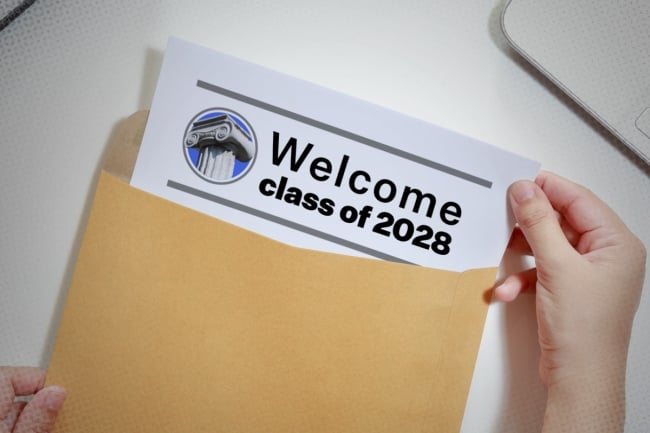You have /5 articles left.
Sign up for a free account or log in.

As the Class of 2028 begins receiving college decision letters, a picture of the year’s admissions data is becoming clearer.
Photo illustration by Justin Morrison/Inside Higher Ed | Kittisak Jirasittichai/iStock/Getty Images
Members of the class of 2028 began receiving their college acceptance (and rejection) letters last week. Acceptance rates at highly selective institutions continued their plunge into the low single digits, with a few notable exceptions. And many public flagships and mid-sized private universities increased their selectivity as well.
But it’s been a tough season all around. The chaos and frustration over the new FAFSA launch has led to a nearly 30 percent decline in completion of the student aid form this year, which advocates fear could mean a marked drop in college-going rates for low-income and first-generation students who rely on federal aid. Meanwhile, everyone is waiting to see how the Supreme Court’s ban on affirmative action could impact access and equity in college admissions.
While data on applicant demographics are scarce this early in the spring and a final picture of the class of 2028 won’t emerge until at least June (if not later), certain early trends are worth highlighting.
Applications Are Up
According to Common App data, the number of applicants increased by nearly 6 percent over last year. While the figure applies only to the 834 member institutions that used the Common App consistently from 2019 to 2024, it’s welcome news after years of stagnant enrollments post-pandemic, and builds on a sizable boost in early applicants in the fall.
Students also applied to slightly more colleges than last cycle, according to the CommonApp data: an average of 5.74 colleges per student, up from 5.66.
At some colleges, applications appeared to rise in direct response to affordability initiatives. Last summer Duke University announced it would offer free tuition for North and South Carolina-based applicants from families making less than $150,000 a year; this cycle Duke received 4,700 more applicants than last year, 1,250 of which were from North or South Carolina. In Minnesota, enrollment at public colleges rose for the first time in a decade after the state implemented a free tuition program for residents making less than $80,000 a year.
But enrollment and application numbers are also up at two-year colleges, and interest in vocational and credential programs is on the rise as faith in the value of a four-year bachelor’s degree hits an all-time low.
Robert Massa, a retired undergraduate enrollment professional with stints at Dickinson College and Johns Hopkins University, said he expects that the combination of students pivoting to shorter-term degrees and the substantial drop in FAFSA completion rates will hit four-year colleges’ yield rates hard come early summer.
“The FAFSA debacle is a big question mark hanging over this year, and it will be really disruptive for regional public universities in particular, those that serve and depend on lower-income populations,” he said. “Students who maybe applied and got into a four-year program might be more likely to consider going to a community college instead—or not going to college at all.”
Acceptance Rates are Down
Admission to highly selective institutions became even more competitive this cycle, as it has for the past decade. Yale University received a record 57,465 applications, for instance—dwarfing its previous record of 52,250 by nearly 10 percent—and had an acceptance rate of 3.7 percent, its lowest ever, down from 4.5 percent last year. Some highly selective non-Ivy institutions also boasted record-low acceptance rates, including Williams College and Rice and Duke Universities.
Harvard’s acceptance rate, however, rose this year, from 3.34 to 3.59 percent, its first increase since 2020; at the same time, applications to the university fell by over 5 percent from last year. The small but notable shift comes after a year of controversy in which Harvard president Claudine Gay was ousted over criticism of her Congressional testimony on campus antisemitism and accusations of plagiarism.
Many public institutions admitted a record low share of applicants. The University of Texas at Austin received a record 73,000 applications this year and only accepted 11 percent of applicants that weren’t automatically admitted through Texas’ guaranteed admissions law, putting it on par with highly selective private institutions like Tufts University and the University of Notre Dame.
Some private universities are also becoming more competitive. Northeastern University received over 90,000 applications, a nearly 30 percent surge over the roughly 62,000 it received in 2019. And Fairfield University in Connecticut admitted 33 percent of applicants this cycle, a steep drop from almost 45 percent last year.
Massa said institutions like Northeastern represent a small slice of the higher ed sector that is adapting to changing times by tying their education model to employment through initiatives like their robust cooperative learning program—and seeing the dividends.
“There are some institutions that haven’t historically been at the top of the name-recognition list, but that have done a great job over the last 10 years distinguishing themselves from their peers,” he said, “That’s because of marketing campaigns, number one, but number two, and more importantly, it’s because they’ve listened to what the students want from their programming. In our current environment, institutions that aren’t doing that are playing with fire.”
Acceptance rates for many institutions have yet to be published, and the most pertinent and highly anticipated data from this year’s admissions cycle—especially demographics at selective colleges—is not yet available. While some of the early data may seem promising, Massa cautioned against undue optimism.
“More applicants and lower acceptance rates are one thing,” Massa said. “Class yield is another entirely.”









